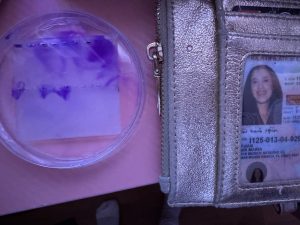12 Molecular Diagnostics and Bioinformatics
Procedure:
- Pipetting Activity: If you haven’t practiced pipetting with silica gel, do so now using your model gel.
- Bioinformatics Activities: Complete the activities in the bioinformatics modules. Watch the provided instructional videos for guidance.
- Bioinformatics 2.0: Try to find a gene, protein, or plasmid related to your “Adopt a Microbe” organism. Retrieve the sequences from NCBI (using the video on sequence retrieval) and apply them to the bioinformatics activities.
- ELN Submission: Submit screenshots of 7 chosen bioinformatics activities in your ELN. For each activity, explain the program’s purpose and interpret the results.
Photo of loaded gel:

Activities:
PCR Virtual Simulation:

The polymerase chain reaction (PCR) is a method used to amplify DNA sequences, with a wide range of applications: laboratory procedures, medical diagnostics, forensics, environmental microbiology:, dentistry, and paternity testing.
The PCR process generally involves three steps:
- Denaturation: The sample is heated to 95–98°C to separate the double-stranded DNA into single strands.
- Annealing: The temperature is lowered to 55–65°C to allow primers to bind to specific DNA sequences.
- Extension: The polymerase extends the single-stranded DNA into double-stranded DNA.
Gel Electrophoresis Virtual Simulation

Gel Electrophoresis Procedure:
- Gel Preparation: Agarose is dissolved in a buffer and heated until it melts, then poured into a mold to solidify into a gel.
- Sample Loading: DNA or protein samples mixed with a loading buffer are loaded into the gel wells.
- Electric Current Application: The gel is placed in an electrophoresis chamber, and an electric current is applied, causing negatively charged molecules (like DNA) to move toward the positive electrode. Smaller molecules move faster.
- Result Visualization: After electrophoresis, the gel is stained with a dye and examined under UV light to see separated bands.
- Analysis: The bands are compared to a DNA ladder to determine the size and composition of the samples.
Gel electrophoresis is a crucial technique for analyzing DNA, proteins, and other biomolecules, enabling the identification of their size and purity. It plays a key role in genetic research, such as DNA fingerprinting, gene mapping, and mutation analysis. In forensics, it is used for DNA profiling, including paternity testing. It also aids in the detection of genetic diseases and pathogens in medical diagnostics. Additionally, gel electrophoresis supports cloning and recombinant DNA technology by separating DNA fragments and is vital in protein research, enhancing our understanding of protein structure and function.
Bioinformatics Virtual Activities:

- NCBI BLAST Alignment 16S Sequence
- Purpose: Identifies the species or related organisms using the 16S rRNA gene, a commonly used marker in bacterial identification and phylogeny studies.


- BLASTing an Unknown Sequence
- Purpose: Compares an unknown DNA or protein sequence against a database to find similar sequences. This is crucial for determining the function, structure, or evolutionary relationships of the unknown sequence.
unknown sequence: GATGAGTCTGCGTCTTATTAGCTAGTTGGTAGGGTAAATGCCTACCAAGGCAATGATAAGTAACCGGCCT
GAGAGGGTGAACGGTCACACTGGAACTGAGATACGGTCCAGACTCCTACGGGAGGCAGCAGCTAAGAA
TCTTCCGCAATGGGCGAAAGCCTGACGGAGCGACACTGCGTGAATGAAGAAGGTCGAA
I found that this sequence is from the Borreliella burgdorferi bacterium.

- Aligning Two Sequences (NCBI)
- Purpose: Aligns two sequences (DNA, RNA, or protein) to determine their similarity. Useful for studying sequence conservation, mutations, or evolutionary relationships.
5. Phylogenetic Analysis
- Purpose: Builds evolutionary trees to study relationships among sequences or organisms. Useful for tracking evolutionary patterns or relatedness.
6. Translation & ProtParam & 3D Structure
- Purpose: Converts nucleotide sequences into protein sequences. Analyzes protein parameters (e.g., molecular weight, isoelectric point, amino acid composition). Explores the 3D structure of proteins to understand their function and interactions.
7. String (Protein-Protein Interactions)
- Purpose: Analyzes and visualizes interactions between proteins. Understanding these interactions helps clarify biological pathways and disease mechanisms.
These activities are integral to studying molecular biology, genomics, and proteomics. They allow researchers to extract meaningful insights from biological data, predict protein function, and study evolutionary relationships.
